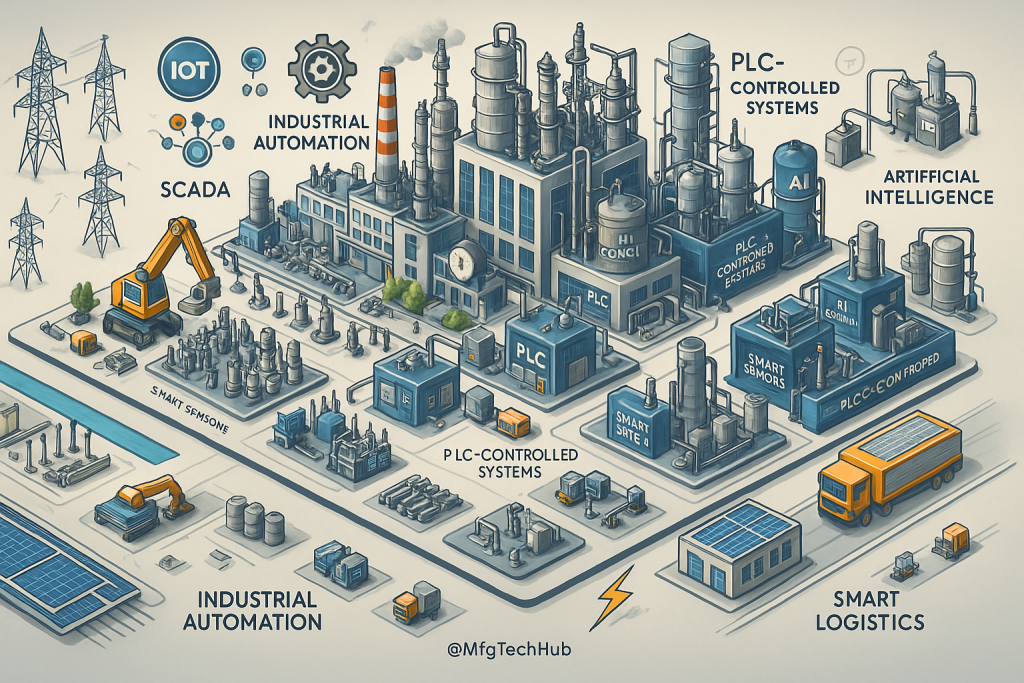Overview of Instrumentation & Electrical Systems
In the world of modern manufacturing and process industries, instrumentation and electrical systems play a central role in ensuring efficiency, automation, and safety. These two domains work hand in hand to measure, monitor, regulate, and control a wide variety of physical and electrical parameters such as temperature, pressure, flow, voltage, and current. Without them, it would be nearly impossible to achieve the levels of precision, scalability, and reliability required in today’s competitive industrial environment.

By integrating advanced instrumentation with robust electrical systems, industries can optimize production, enhance quality control, and minimize downtime. With the rise of smart factories and Industry 4.0, the traditional role of electrical wiring and analog gauges has expanded into a world of IoT-enabled sensors, automation platforms, AI-powered analytics, and predictive maintenance tools. This shift is not only improving productivity but also making manufacturing more sustainable and safe.
Understanding Industrial Instrumentation
Industrial instrumentation is the science of measurement and control. In every manufacturing process—whether in chemical plants, oil refineries, food processing facilities, or pharmaceutical industries—precise measurement is crucial. Even a small deviation in pressure, temperature, or chemical dosing can lead to defective products, safety hazards, or costly downtime.
Key Components of Industrial Instrumentation
- Sensors and Transducers: Devices that convert physical quantities like temperature, pressure, flow, or vibration into measurable electrical signals. For example, a pressure transducer in an oil pipeline constantly measures variations to avoid ruptures.
- Transmitters: These send sensor signals to control systems in standardized formats such as 4–20 mA or digital protocols like HART, Profibus, or OPC UA.
- Controllers: Often PLCs (Programmable Logic Controllers) or DCS (Distributed Control Systems), these receive signals, run logic or algorithms, and decide how a process should be adjusted.
- Actuators: Mechanical devices that perform actions—such as opening a valve, adjusting a motor’s speed, or stopping a pump—based on controller commands.
- Data Acquisition Systems (DAQ): Platforms that collect, process, and store real-time sensor data, enabling advanced analytics and predictive maintenance strategies.
In essence, instrumentation acts as the “nervous system” of industrial plants, constantly feeding data to the brain (control systems) to ensure smooth and safe operations.
The Role of Electrical Systems in Manufacturing
If instrumentation is the nervous system, then electrical systems are the lifeblood. No manufacturing facility can function without reliable electrical infrastructure. Electrical systems ensure continuous power supply, safe distribution, and efficient operation of all machinery and automation platforms.
Key Components of Industrial Electrical Systems
- Power Supply Units: Convert raw electrical energy into usable forms such as AC/DC for industrial equipment.
- Circuit Breakers & Safety Devices: Protect machines and workers by preventing overloads, short circuits, or electrical fires.
- Electric Motors & Drives: Motors power conveyors, pumps, fans, and compressors, while drives adjust speed and torque for efficiency.
- Switchgear & Transformers: Distribute power across different voltage levels and provide isolation for safety.
- Industrial Lighting Systems: Ensure safe visibility while adopting energy-efficient technologies like LED and smart lighting.
For instance, in a car manufacturing plant, electrical systems power the robotic arms on assembly lines, while instrumentation ensures precision in welding, painting, and quality testing.
Why Instrumentation & Electrical Systems are Essential in Manufacturing
1. Process Control & Optimization
Instrumentation ensures that critical parameters stay within desired ranges. For example, in a pharmaceutical plant, precise temperature and pressure control during drug formulation ensures product quality and compliance with regulations. Automation reduces human error, speeds up production, and enables consistent quality.
2. Energy Efficiency & Cost Reduction
Electrical systems with variable frequency drives (VFDs) adjust motor speeds, cutting unnecessary power consumption. Smart grids further optimize energy distribution, helping factories save millions annually while reducing environmental footprints.
3. Workplace Safety & Hazard Prevention
Instrumentation detects unsafe conditions—such as gas leaks, overheating motors, or abnormal pressure spikes—long before they become hazards. Electrical systems provide protection via breakers, fuses, and grounding systems, ensuring safe working environments.
4. Predictive Maintenance & Downtime Reduction
With IoT-enabled sensors and AI-based analytics, industries can predict equipment failures before they happen. Instead of reactive maintenance after breakdowns, predictive maintenance minimizes unplanned downtime and extends equipment life cycles.
5. Industry 4.0 & Smart Manufacturing Integration
Modern factories connect all instrumentation and electrical assets into a centralized digital ecosystem. AI platforms analyze sensor data, identify inefficiencies, and suggest optimizations. For example, if a motor is consuming more power than usual, the system alerts operators and recommends corrective actions.
Advancements in Industrial Instrumentation & Electrical Systems
1. IoT & Smart Sensors
Next-generation wireless sensors provide continuous insights into machine performance. A remote operator can check vibration data from turbines or compressors on their smartphone, making operations more transparent and agile.
2. AI & Machine Learning
AI systems crunch years of historical machine data to detect hidden patterns. For example, an AI algorithm may forecast that a pump bearing will fail in 3 weeks, giving maintenance teams ample time to schedule repairs without halting production.
3. 5G & Edge Computing
High-speed communication allows instant machine-to-machine data exchange. Edge devices process data locally instead of sending everything to the cloud, reducing latency. This is crucial in applications like robotic welding or automated packaging, where split-second timing matters.
4. Renewable Energy Integration
As industries aim for carbon neutrality, electrical systems are evolving to integrate solar panels, wind turbines, and battery storage. Intelligent energy management systems ensure renewable energy is used optimally while maintaining stable plant operations.
Conclusion
Instrumentation and electrical systems form the foundation of industrial automation. From ensuring consistent quality in production lines to safeguarding workers from hazards, their importance cannot be overstated. As technology advances, industries are moving toward smarter, safer, and more sustainable solutions powered by IoT, AI, and renewable energy integration.
The factories of the future will not only produce goods but also operate as intelligent ecosystems—self-monitoring, self-optimizing, and highly adaptive to market demands. Companies that invest in advanced instrumentation and electrical infrastructure today are laying the groundwork for a future of greater productivity, lower costs, and enhanced sustainability.
